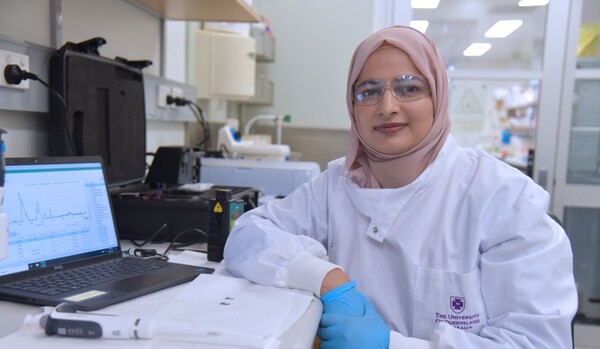
A groundbreaking study led by a University of Queensland PhD student is set to transform ovarian cancer diagnosis. Javeria Bashir, from UQ’s School of Mechanical and Mining Engineering, is pioneering the use of sponge-like gold nanoparticles to enhance the accuracy and accessibility of ovarian cancer detection, particularly for women in remote areas.
Bashir’s innovative approach utilizes specially designed gold nanoparticles that function as tiny light amplifiers, capable of identifying cancer markers in patient samples such as blood, urine, or saliva. The aim is to improve survival rates for a disease often diagnosed too late. “Ovarian cancer rarely shows clear symptoms in its early stages, and diagnosis is often complex,” Bashir explained. “Current methods make it difficult to accurately distinguish women with ovarian cancer from those with benign conditions, often necessitating painful and invasive procedures like tissue biopsies. This creates an unacceptable situation for women, as there is currently no effective and accessible test to accurately identify ovarian cancer and prevent unnecessary procedures.”
Innovative Use of Gold Nanoparticles
Collaborating with experts from UQ’s Australian Institute for Bioengineering and Nanotechnology, the Centre for Clinical Research, and the Centre for Extracellular Vesicle Nanomedicine, Bashir explored the unique biosensing capabilities of mesoporous gold nanoparticles. By employing a technique known as Surface-Enhanced Raman Scattering (SERS), she significantly enhanced the sensitivity of gold-enhanced light sensors.
“SERS platforms are already highly sensitive and can detect biomarkers at the nanoscale,” Bashir noted. “Using mesoporous gold nanoparticles increased that sensitivity even further compared to nonporous or commercially available nanoparticles. Essentially, the gold particles act like tiny light amplifiers, creating hotspots that reveal even the faintest traces of cancer.”
Clinical Trials and Results
The diagnostic method combines a simple tube for the patient sample with a handheld Raman spectrophotometer. In trials, this approach outperformed current blood tests, achieving 82 percent sensitivity in confirming ovarian cancer and 98 percent specificity in ruling it out. These results highlight the potential of gold nanoparticles to revolutionize cancer diagnostics.
“This project demonstrates how mesoporous nanotechnologies can help us transform disease monitoring and pave the way for personalized treatment strategies,” Bashir stated. “Devices like this are moving closer and closer to everyday use.”
Implications for Remote and Underserved Communities
Beyond clinical accuracy, the portability and affordability of this technology could significantly impact women who face barriers to testing. The research was published in the journal Small, with contributions from the Mater Research Institute and Oregon Health and Science University. Bashir’s work was supervised by Associate Professor Md Shahriar A. Hossain, Dr. Mostafa Kamal Masud, Professor Yusuke Yamauchi, and Professor Carlos Salomon, who provided both conceptual and clinical guidance.
Future Prospects and Broader Impact
As ovarian cancer remains one of the most challenging diseases to detect early, the development of gold-based nanosensors offers a promising alternative. This advancement could lead to less invasive and more reliable methods for triaging women, ultimately facilitating faster treatment and improving survival outcomes.
The announcement comes as the medical community continues to seek innovative solutions to enhance early cancer detection. The move represents a significant step forward in personalized medicine, potentially reshaping how ovarian cancer is diagnosed and managed worldwide.
Meanwhile, the research community is optimistic about the broader applications of mesoporous nanotechnologies in other areas of disease detection and treatment. As these technologies advance, they may pave the way for more accessible healthcare solutions, particularly in underserved regions.
According to sources, ongoing research and development efforts are crucial to refining these technologies and ensuring their integration into routine clinical practice. The future of cancer diagnostics may well be shaped by the tiny yet powerful gold nanoparticles that Bashir and her team have brought to the forefront.






